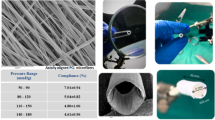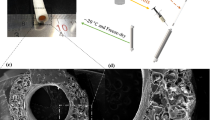Abstract
Thrombosis is the main cause of failure of small-diameter synthetic vascular grafts when used for by-pass procedures. The development of bioresorbable vascular scaffolds with localized and sustained intra-luminal antithrombotic drug release could be considered a desirable improvement towards a valuable solution for this relevant clinical need. For this aim, we present the fabrication and characterization of aspirin-loaded electrospun poly(ε-caprolactone) tubular scaffolds as a vascular drug-delivery graft. Three different drug concentrations were considered (i.e., 1, 5 or 10 % w/w). Although a fibrous structure was clearly observed for all the collected scaffolds, aspirin content was directly implied in the final microstructure leading to a bimodal fiber diameter distribution and fused fibers at crossing-points (5 or 10 % w/w). Mechanical response highlighted a direct relationship for modulus and stress at break with the aspirin content, while the elongation at break was not remarkably different for the investigated cases. The temporal drug release was strongly dependent from the amount of loaded aspirin, reaching a steady state release after about 50 h. Finally, the adhesion assay confirmed the capability of the electrospun scaffolds to reduce platelet adhesion/aggregation onto aspirin loaded polymeric fibers. Aspirin-loaded electrospun tubular scaffold could represent a feasible candidate to develop a novel bioresorbable drug-releasing graft for small-diameter vessel replacements.




Similar content being viewed by others
References
European cardiovascular disease statistics. European Heart Network; 2008.
Yusuf S, Ounpuu S, Anand S. The global epidemic of atherosclerotic cardiovascular disease. Med Princ Pract. 2002;11(Suppl 2):3–8.
Hashi CK, Derugin N, Janairo RR, Lee R, Schultz D, Lotz J, Li S. Antithrombogenic modification of small-diameter microfibrous vascular grafts. Arterioscler Thromb Vasc Biol. 2010;30:1621–7.
Pektok E, Nottelet B, Tille JC, Gurny R, Kalangos A, Moeller M, Walpoth BH. Degradation and healing characteristics of small-diameter poly(ε-caprolactone) vascular grafts in the rat systemic arterial circulation. Circulation. 2008;118:2563–70.
Nottelet B, Pektok E, Mandracchia D, Tille JC, Walpoth B, Gurny R, Möller M. Factorial design optimization and in vivo feasibility of poly(ε-caprolactone)-micro- and nanofiber-based small diameter vascular grafts. J Biomed Mater Res A. 2009;89:865–75.
Innocente F, Mandracchia D, Pektok E, Nottelet B, Tille JC, de Valence S, Faggian G, Mazzucco A, Kalangos A, Gurny R, Moeller M, Walpoth BH. Paclitaxel-eluting biodegradable synthetic vascular prostheses, a step towards reduction of neointima formation? Circulation. 2009;120(suppl 11):S37–45.
Sarkar S, Sales KM, Hamilton G, Seifalian AM. Addressing thrombogenicity in vascular graft construction. J Biomed Mater Res B. 2007;82:100–8.
Jämstorp E, Bodin A, Gatenholm P, Jeppsson A, Strømme M. Release of antithrombotic drugs from alginate gel beads. Curr Drug Deliv. 2010;7:297–302.
Field TS, Benavente OR. Current status of antiplatelet agents to prevent stroke. Curr Neurol Neurosci Rep. 2011;11:6–14.
CAPRIE steering committee. A randomised, blinded, trial of clopidogrel versus aspirin in patients at risk of ischaemic events (CAPRIE). Lancet. 1996;348:1329–39.
Badruddin A, Gorelick PB. Antiplatelet therapy for prevention of recurrent stroke. Curr Treat Options Neurol. 2009;11:452–9.
Kral M, Herzig R, Sanak D, Skoloudik D, Vlachova I, Bartkova A, Hlustik P, Kovacik M, Kanovsky P. Oral antiplatelet therapy in stroke prevention. Minireview. Biomed Pap Med Fac Univ Palacky Olomouc Czech Repub. 2010;154:203–10.
Guslandi M. Gastric toxicity of antiplatelet therapy with low-dose aspirin. Drugs. 1997;53:1–5.
Sztriha LK, Sas K, Vecsei L. Aspirin resistance in stroke: 2004. J Neurol Sci. 2005;229:163–9.
Hall JD, Rittgers SE, Schmidt SP. Effect of controlled local acetylsalicylic acid release on in vitro platelet adhesion to vascular grafts. J Biomater Appl. 1994;8:361–84.
Guyton AC. Textbook of medical physiology. 7th ed. Philadelphia: W.B. Saunders Co.; 1986.
Wulf K, Teske M, Löbler M, Luderer F, Schmitz KP, Sternberg K. Surface functionalization of poly(ε-caprolactone) improves its biocompatibility as scaffold material for bioartificial vessel prostheses. J Biomed Mater Res B. 2011;98:89–100.
Allen BT, Sparks RE, Welch MJ, Mason NS, Mathias CJ, Clark RE. Reduction of platelet deposition on vascular grafts using an antiplatelet graft coating technique. J Surg Res. 1984;36:80–8.
Tang Y, Singh J. Controlled delivery of aspirin: effect of aspirin on polymer degradation and in vitro release from PLGA based phase sensitive systems. Int J Pharm. 2008;357:119–25.
Cortizo MS, Alessandrini JL, Etcheverr SB, Cortizo AM. A vanadium/aspirin complex controlled release using a poly (β-propiolactone) film. Effects on osteosarcoma cells. J Biomater Sci Polym Ed 2001;12:945–59.
Yoon H, Kim G. A three-dimensional polycaprolactone scaffold combined with a drug delivery system consisting of electrospun nanofibers. J Pharm Sci. 2011;100:424–30.
Del Gaudio C, Grigioni M, Bianco A, De Angelis G. Electrospun bioresorbable heart valve scaffold for tissue engineering. Int J Artif Organs. 2008;31:68–75.
Liu SJ, Chiang FJ, Hsiao CY, Kau YC, Liu KS. Fabrication of balloon-expandable self-lock drug-eluting polycaprolactone stents using micro-injection molding and spray coating techniques. Ann Biomed Eng. 2010;38:3185–94.
Woodruff MA, Hutmacher DW. The return of a forgotten polymer—polycaprolactone in the 21st century. Prog Polym Sci. 2010;35:217–56.
Lee SJ, Yoo JJ, Lim GJ, Atala A, Stitzel J. In vitro evaluation of electrospun nanofiber scaffolds for vascular graft application. J Biomed Mater Res A. 2007;83:999–1008.
McClure MJ, Sell SA, Ayres CE, Simpson DG, Bowlin GL. Electrospinning-aligned and random polydioxanone-polycaprolactone-silk fibroin-blended scaffolds: geometry for a vascular matrix. Biomed Mater. 2009;4:055010.
Bakar SK, Niazi S. Stability of aspirin in different media. J Pharm Sci. 1983;72:1024–6.
Wan LS, Xu ZK. Polymer surfaces structured with random or aligned electrospun nanofibers to promote the adhesion of blood platelets. J Biomed Mater Res A. 2009;89:168–75.
Yarin AL, Kataphinan W, Reneker DH. Branching in electrospinning of nanofibers. J Appl Phys. 2005;98:064501.
Gentsch R, Boysen B, Lankenau A, Börner HG. Single-step electrospinning of bimodal fiber meshes for ease of cellular infiltration. Macromol Rapid Commun. 2010;31:59–64.
Li WJ, Cooper JA Jr, Mauck RL, Tuan RS. Fabrication and characterization of six electrospun poly(α-hydroxy ester)-based fibrous scaffolds for tissue engineering applications. Acta Biomater. 2006;2:377–85.
Kim JH, Kim SH, Kim HK, Akaike T, Kim SC. Adhesion and growth of endothelial cell on amphiphilic PU/PS IPN surface: effect of amphiphilic balance and immobilized collagen. J Biomed Mater Res A. 2002;62:613–21.
Amornsakchai T, Cansfield DLM, Jawad SA, Pollard G, Ward IM. The relation between filament diameter and fracture strength for ultra-high-modulus polyethylene fibres. J Mater Sci. 1993;28:1689–98.
Del Gaudio C, Fioravanzo L, Folin M, Marchi F, Ercolani E, Bianco A. Electrospun tubular scaffolds: on the effectiveness of blending poly(ε-caprolactone) with poly(3-hydroxybutyrate-co-3-hydroxyvalerate). J Biomed Mater Res B. 2012;100B:1883–98.
Stankus JJ, Soletti L, Fujimoto K, Hong Y, Vorp DA, Wagner WR. Fabrication of cell microintegrated blood vessel constructs through electrohydrodynamic atomization. Biomaterials. 2007;28:2738–46.
Donovan DL, Schmidt SP, Townshend SP, Njus GO, Sharp WV. Material and structural characterization of human saphenous vein. J Vasc Surg. 1990;12:531–7.
Lam CXF, Savalani MM, Teoh S, Hutmacher DW. Dynamics of in vitro polymer degradation of polycaprolactone-based scaffolds: accelerated versus simulated physiological conditions. Biomed Mater. 2008;3:1–15.
Ritger PL, Peppas NA. A simple equation for description of solute release I. Fickian and non-Fickian release from non-swellable devices in the form of slabs, spheres, cylinders or discs. J Control Release. 1987;5:23–36.
Siepmann J, Peppas NA. Modeling of drug release from delivery systems based on hydroxypropyl methylcellulose (HPMC). Adv Drug Deliv Rev. 2001;48:139–57.
Szentivanyi A, Chakradeo T, Zernetsch H, Glasmacher B. Electrospun cellular microenvironments: understanding controlled release and scaffold structure. Adv Drug Deliv Rev. 2011;63:209–20.
Lao LL, Peppas NA, Boey FY, Venkatraman SS. Modeling of drug release from bulk-degrading polymers. Int J Pharm. 2011; 418:28–41.
Hong Y, Ye SH, Nieponice A, Soletti L, Vorp DA, Wagner WR. A small diameter, fibrous vascular conduit generated from a poly(ester urethane)urea and phospholipid polymer blend. Biomaterials. 2009;30:2457–67.
Acknowledgments
The authors thank the Cord Blood Bank, Department of Hematology, University Hospital Careggi, Florence, for kindly providing the cord blood samples. CDG acknowledges the Italian Interuniversity Consortium on Materials Science and Technology (INSTM) for the financial support of the scientific activity, Co-funded Grant “Progettazione, realizzazione e caratterizzazione funzionale di scaffold polimerici elettrofilati per l’ingegneria del tessuto cardiovascolare”.
Author information
Authors and Affiliations
Corresponding authors
Rights and permissions
About this article
Cite this article
Del Gaudio, C., Ercolani, E., Galloni, P. et al. Aspirin-loaded electrospun poly(ε-caprolactone) tubular scaffolds: potential small-diameter vascular grafts for thrombosis prevention. J Mater Sci: Mater Med 24, 523–532 (2013). https://doi.org/10.1007/s10856-012-4803-3
Received:
Accepted:
Published:
Issue Date:
DOI: https://doi.org/10.1007/s10856-012-4803-3




